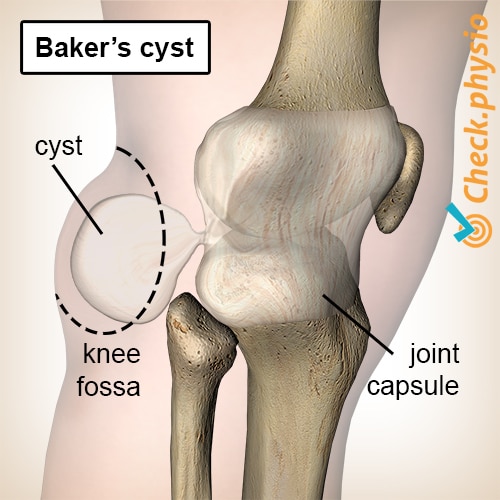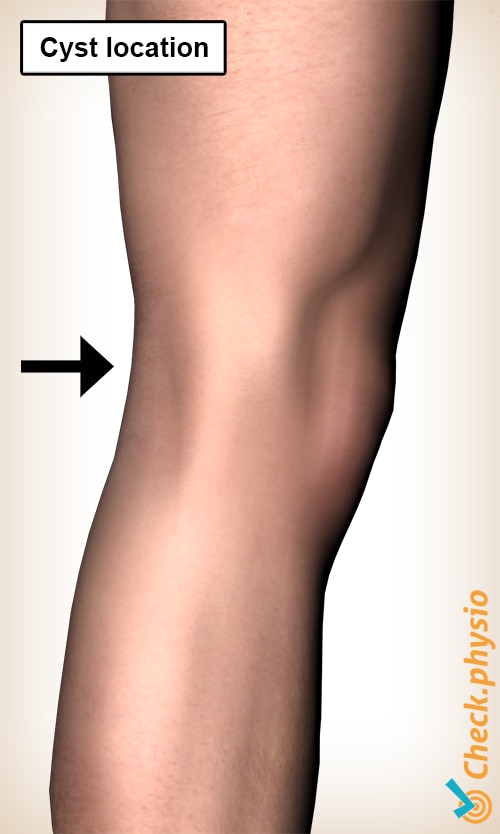Baker's cyst
Swelling in the back of the knee / popliteal cyst
In case of a Baker's cyst, swelling occurs in the back of the knee and the cavity becomes filled with fluid. A cyst is often the result of another, underlying knee problem.

A Baker's cyst is a harmless swelling in the back of the knee, which can get in the way when moving, causing pain and restricting movement.
Description of the condition
In every joint, including the knee, synovial fluid (synovium) is present to lubricate the joint so that it can move smoothly. A Baker's cyst develops when too much of this fluid is produced. This increases the pressure in the joint and the joint capsule will bulge out at the back. This is because the capsule is at its weakest in this area and is not covered by muscles. This swelling may vary in size from day to day.
The swelling can cause blood vessels or nerves in the knee to become compressed; fortunately, this is rare. Usually, more synovial fluid is produced because there is irritation or damage elsewhere in the knee. A Baker's cyst can also rupture, which can be very painful.
A Baker's cyst is a benign condition and can develop in anyone, male or female, of any age.
Cause and origin
The Baker's cyst is usually caused by another condition in the knee that results in an excessive production of synovial fluid, such as damage to the joint surface, osteoarthritis, rheumatism, meniscus injury, or a loose bone particle. The injury must be within the joint capsule for it to cause a Baker’s cyst.
Sometimes a Baker’s cyst also develops without a clear cause.
Signs & symptoms
The symptoms that occur with a Baker's cyst are generally mild. They depend on the strain on the knee, the size of the swelling and the severity of any underlying problem. Complaints that can be present with a Baker's cyst:
- Swelling in the back of the knee leading to a restriction of movement.
- Tightness, throbbing sensations and/or pain in the back of the knee.
- The presence of another knee problem such as osteoarthritis, rheumatism, meniscus injury, etc.
Diagnosis
When the back of the knee swells, a doctor or physiotherapist will ask about the duration and nature of the symptoms. A physical examination will then look not only at the back of the knee, but also at any other problems in the knee that may explain the swelling. It may then be necessary to carry out additional testing in the form of an ultrasound, X-ray, MRI or arthroscopy.
Treatment
A Baker's cyst does not always need to be treated. When the cyst gives no or few complaints, reassurance is often sufficient. A Baker's cyst usually disappears on its own if the cause of the extra fluid production in the knee is treated.
Another option is to use a needle to drain the cyst. An anti-inflammatory will then also be injected. However, this is usually a temporary solution as the cause of the problem is not addressed.
Surgery
In exceptional cases, the cyst is surgically removed. This of course creates a hole in the capsule of the back of the knee. This is sealed with a kind of mesh.
It is very important to address any underlying problem of the knee. As long as this problem is not addressed, there is a good chance that the cyst will continue to exist or recur.
Exercises
You can check your symptoms using the online physiotherapy check or make an appointment with a physiotherapy practice in your area.

References
Schünke, M., Schulte, E. & Schumacher, U. (2005). Prometheus. Algemene anatomie en bewegingsapparaat. Houten: Bohn Stafleu Van Loghum.
Verhaar, J.A.N. & Linden, A.J. van der (2005). Orthopedie. Houten: Bohn Stafleu van Loghum.



